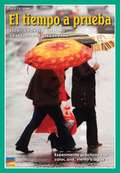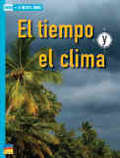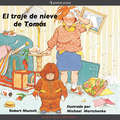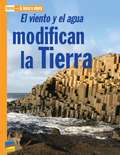- Table View
- List View
El rey de Egipto (¡Arriba la Lectura!, Level R #54)
by Diana Platt Pam RushbyNIMAC-sourced textbook
El río Misisipi (¡Arriba la Lectura!, Level N #43)
by Annette SmithNIMAC-sourced textbook. ¿Sabías que el río Misisipi es uno de los más largos de América del Norte? ¿O que Mark Twain y otros escritores famosos escribieron muchas historias sobre él? Descubre todo sobre el Misisipi y sobre cómo este río imponente influye sobre las vidas de las personas que viven cerca de él.
El secreto – Libro 1: Cuidado con la magia (El secreto #1)
by Katrina Kahler Aranzazu SánchezCuando Tess, una chica de 12 años, se muda a un nuevo barrio, intenta hacerse amiga del chico que vive en la casa de al lado, que tiene la misma edad y se llama Sam. Tess ignora que Sam tiene un poder especial, un poder que debe mantener en secreto cueste lo que cueste. No, no puede leer la mente, pero es capaz de otra cosa que a veces le cuesta controlar. Los otros chicos piensan que es raro y lo intentan evitar, pero con la llegada de Tess, todo cambia. No obstante, Sam no es el único que siente interés por Tess. El chico más popular del curso, Jake Collins, comienza a interesarse por ella y Sam decide que ya no tiene esperanza alguna. Entonces, cuando los abusos de Jake empeoran, Sam se ve obligado a enseñarle una lección. Pero, ¿qué pasa si Sam llegase demasiado lejos? ¿Y si Tess descubriese de lo que es capaz? Si te gustan las lecturas sobre niños con poderes especiales y si te gustó mi colección Telépata, estoy segura de que también disfrutarás de esta colección. Es otra emocionante historia repleta de drama, suspense, romance, rivalidades, amistad y mucho, mucho más. Un libro lleno de suspense para chicas que no querrás dejar de leer.
El secreto – Poder de la Mente Libro 3
by Katrina Kahler Betty SerranoEl secreto – Poder de la Mente, Libro 3. Este libro fue especialmente escrito para chicos y chicas de 9 a 12 años, de habla hispana en America y España
El señor Lawson tiene razón (¡Arriba la Lectura!, Level T #83)
by Pamela Rushby Nathalie OrtegaNIMAC-sourced textbook
El sueño de Danny (¡Arriba la Lectura!, Level O #13)
by Jack Gabolinscy Karen OppattNIMAC-sourced textbook
El sueño de Emmanuel: La verdadera historia de Emmanuel Ofosu Yeboah (¡Arriba la Lectura!, Read Aloud Module 5 #4)
by Laurie Thompson Sean QuallsNIMAC-sourced textbook
El tiempo y los animales (¡Arriba la Lectura!, Level C #56)
by Melissa BurkeNIMAC-sourced textbook. ¿Qué hacen los animales cuando llueve, nieva y sopla el viento? ¡Lee y lo sabrás!
El traje de nieve de Tomás
by Robert Munsch Michael MartchenkoTomás se niega a ponerse su traje de nieve a pesar de las súplicas de su madre, su maestra y hasta el director de la escuela.
El traje nuevo del emperador: Cuento de Hans Christian Andersen (¡Arriba la Lectura!, Level K #88)
by Doug Roy Robina WillsonDos tejedoras engañan al emperador y a sus ministros. Lee el cuento de hadas y la obra de teatro para saber qué pasa con el emperador. NIMAC-sourced textbook
El trombón problemático del tío Jacob (¡Arriba la Lectura!, Level O #10)
by John Parsons Rae DaleNIMAC-sourced textbook
El uso del tiempo y del dinero: Textos Para La Lectura Atenta (Texts Close Reading )
by Benchmark Education Co., LLC StaffNIMAC-sourced textbook
El viaje a Colina Rocosa (¡Arriba la Lectura!, Level P #75)
by Susy Boyer Jill McDougallNIMAC-sourced textbook
El viaje de acampada que cambió Estados Unidos: Theodore Roosevelt, John Muir, y nuestros parques nacionales (¡Arriba la Lectura!, Read Aloud Module 7 #2)
by Mordicai Gerstein Barb RosenstockNIMAC-sourced textbook
El viejo carro del abuelo (¡Arriba la Lectura!, Level I #12)
by Annette Smith Anne SpudvilasMi abuelo tiene un carro viejo. No va tan rápido como su carro nuevo. ¡Pero a él le encanta su viejo carro! NIMAC-sourced textbook
El zorro y la cigüeña (¡Arriba la Lectura!, Level H #60)
by Annette Smith Tamsin HinrichsenEl zorro le hace una broma a su amiga la cigüeña. Pero la cigüeña le enseña al zorro algo sobre la amistad. NIMAC-sourced textbook
El ídolo del hockey sobre hielo (¡Arriba la Lectura!, Level L #5)
by Jill McDougall Wayne BryantNIMAC-sourced textbook
El único e incomparable Iván (¡Arriba la Lectura!, Trade Book #10)
by Katherine Applegate Patricia Castelao Mercedes GuhlNIMAC-sourced textbook








